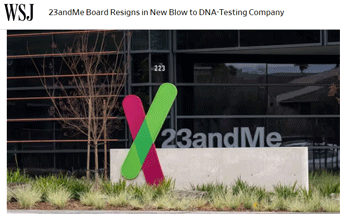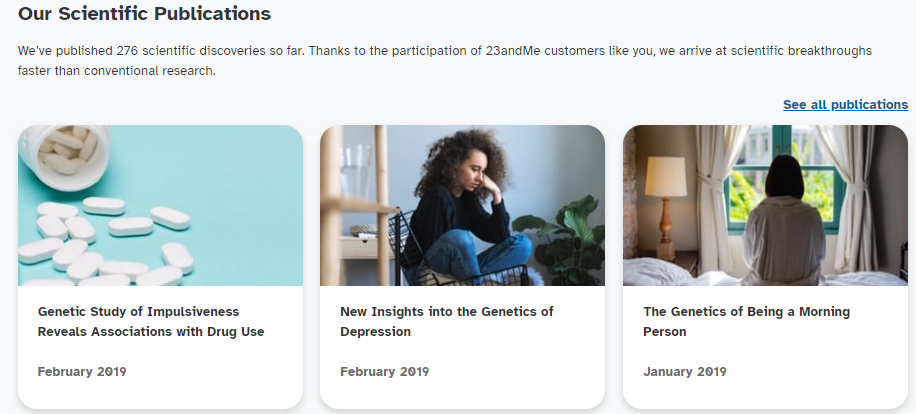23andme started out by being a leader in the direct-to-consumer (DTC) genomic testing business. Time Magazine named it the 2008 Invention of the Year![1] It was the first place I tested my own autosomal DNA and that of many family members back in 2011-2012. Originally it had the best cousin matching tools, best ethnicity estimates, and had a well designed interface to examine the health implications in your own genome. Now I recommend to most that they start with Ancestry DNA and then upload that data to several other sites, including Promethease for the medical analysis, although 23andme still tests a wider range of health related genes.
 23andme has been in the news this week because its entire board, except its founder, Anne Wojcicki, resigned over her plan to take it private again. It went public in 2021 but has yet to turn a profit and the WSJ reports that it will run out of cash next year [ref WSJ]. However there is at least one company interested in buying it according to a post on the DNA-Newbie list.
23andme has been in the news this week because its entire board, except its founder, Anne Wojcicki, resigned over her plan to take it private again. It went public in 2021 but has yet to turn a profit and the WSJ reports that it will run out of cash next year [ref WSJ]. However there is at least one company interested in buying it according to a post on the DNA-Newbie list.
How should those of us who have tests there react to this news? Personally I am not worried, mainly because I hardly ever use the site anymore. I have long since downloaded my data and have contacted most of my closer matches. Roberta Estes has done a thorough blog post (click here) explaining how to save your data from 23andme.
The reason I rarely use 23andme is because it no longer allows you to compare your DNA to a relative in a chromosome browser; the feature I liked the best. I now do that at GEDmatch, Family Tree DNA, and MyHeritage. That tool was removed because of a data breach over a year ago where a hacker got lists of Jewish and Chinese testers and posted them for sale on the dark web. The break-in took advantage of users who had the same email and password on multiple sites, some of which had been exposed elsewhere.
Perhaps it is the resulting class action suit that caused part of 23andme’s financial woes. Click here for an article about how that is being settled with users.
My understanding was that the inspiration for the founding of 23andme was that Genia Brin, the mother of the then husband of founder Anne Wojcicki, was diagnosed with Parkinson’s in 1998 [ref michaelfox org]. The focus of 23andme has always been on discovering the genetic basis of various medical issues, not genealogy. However they have been quite supportive of adoptees (click here), since it is helpful to know what issues may lie in your DNA when you have no known family health history.
One way to look at the genetic basis of various diseases is to crowd-source lots of genomes.
The type of test that 23andme sells is actually a very small sample of your DNA, about .01%. Note that “All human beings are 99.9 percent identical in their genetic makeup” [ref NIH]. Thus it makes sense to test only a subset of alleles which differ and are significant. Periodically, 23andme asks its users to fill out questionnaires about their health and traits (under the Research menu tab click on Surveys and Studies), some of which have led to interesting discoveries. Click here for their report on Parkinson’s variants.

23andme has had many successes with this approach. According to their research page: “Using genome-wide association studies (GWAS) with sample sizes that can exceed one million participants, we have identified genetic associations with Parkinson’s, spontaneous preterm birth, susceptibility for common infections, and schizophrenia — just to name a few.” The focus at 23andme has always been on what health issues lurk in your DNA. Not surprisingly, the FDA came after them in 2013 for marketing “an unclassified medical device.” This caused a discontinuation of the health reports until each one received an authorization (click here for more details).
So why is 23andme not profitable? Well it turns out that discovering what health issues you might be susceptible to because of your DNA is not a big motivator for getting tested. Many Americans want to know their ethnic roots, for example, do they really have a native American ancestor? Genealogists may be the largest group who are interested in these tests in order to better understand their family history and find new relatives. Therefore once Ancestry.com started selling DNA tests, within a few years its market share exceeded 23andme’s by more than double. Leah Larkin periodically publishes the sizes of the DNA databases over time, click here for her page with that chart.
Another problem for 23andme is that DNA kits are a one time sale. Sites such as Ancestry and MyHeritage can follow up by selling subscriptions to their genealogy databases while 23andme can only offer updated health reports. I confess, I have not purchased the latter.
All in all, I am grateful to 23andme for the ease of looking up an individual gene or SNP (click on the menu under your name, then on Resources, then on Browse Raw Genotyping Data), as well as for all the Norwegian relatives I found early on. Also for the chromosome by chromosome ethnicity analysis (click on Chromosome Painting in the Scientific Details section of Ancestry Composition). Click here for my 2019 write up of how to use the site when it was easier to find those features. I really miss the chromosome browser tools.
I am happy to have contributed to their research by regularly filling out their surveys. Let’s hope they find a good buyer.
[1]Utah Law Digital Commons, 12-2017, Development of the Personal Genomics Industry by Jorge L. Contrera.
Disclaimer: many of the links in this article are affiliate links
Thanks Kitty for that succinct analysis. I too rarely use the site anymore. Sadly, when my Mom was alive I decided to change things up and have her test with 23&Me instead of Ancestry. I have been kicking myself ever since. Mainly because of the larger database at Ancestry. But, I have uploaded her results to all the other sites.
I too hope they find a buyer and can straighten things out.
If I uploaded to Promethease years ago. IF I pay for a “new” report now, will it show updated information? Or is there some way to get updates from a previous upload. (My DNA raw data has not changed.)
Thanks for all you do — to keep us informed!
Carol, since they do not store your DNA data, you would have to buy it again but the price is quite reasonable ($15 last time I did this). You can save the report on your pc, however there are always updates to what is known.
And you are welcome…
THANKS. I’ll continue my form — and it’s only asking for $12 today.
I miss in-person meetings with YOU!
I did not know Promethease was still around. When did they re-birth? Off topic, but please tell me which of the testing companies has the best Ethnicity predictions. Thank you!
Caith,
Promethease was bought by MyHeritage. I was not aware it ever went away. It uses SNPedia for its information
Ancestry currently has the best ethnicity predictions. It uses users’ trees for predicting genetic communities.
Pingback: Friday’s Family History Finds | Empty Branches on the Family Tree
Pingback: This week's crème de la crème - September 28, 2024 - Genealogy à la carteGenealogy à la carte
This post offers a comprehensive look at the evolution of 23andMe and its current challenges. It’s interesting to see how it started as a pioneer in DTC genetic testing but has faced significant shifts in the market, especially with the rise of AncestryDNA. The removal of key features, like the chromosome browser, has definitely diminished its appeal for those of us interested in genealogy.
I appreciate the historical context you provided, especially regarding the impact of Genia Brin’s diagnosis on the company’s founding. It’s a reminder of the personal stories behind these technologies.
The point about the one-time sale nature of DNA kits is crucial—recurring subscription models like those of Ancestry and MyHeritage create a sustainable revenue stream that 23andMe lacks. I, too, have found value in their health insights and have enjoyed participating in surveys, but I wonder how they plan to adapt moving forward.
Pingback: Genealogy Software Briefs - Sep 30, 2024 | GenealogySoftware.net
I have always loved 23 & Me. For some reason, it’s where I discovered the most adoptions & they had the relationships for other matches-in-common long before Ancestry’s ProTools. There are also matches on there that are only on that site. I keep hoping for the return of the chromosome browser if even for a short time because I had an amazing match of 6 people only through X that brought me back to a specific Townland in Ireland.